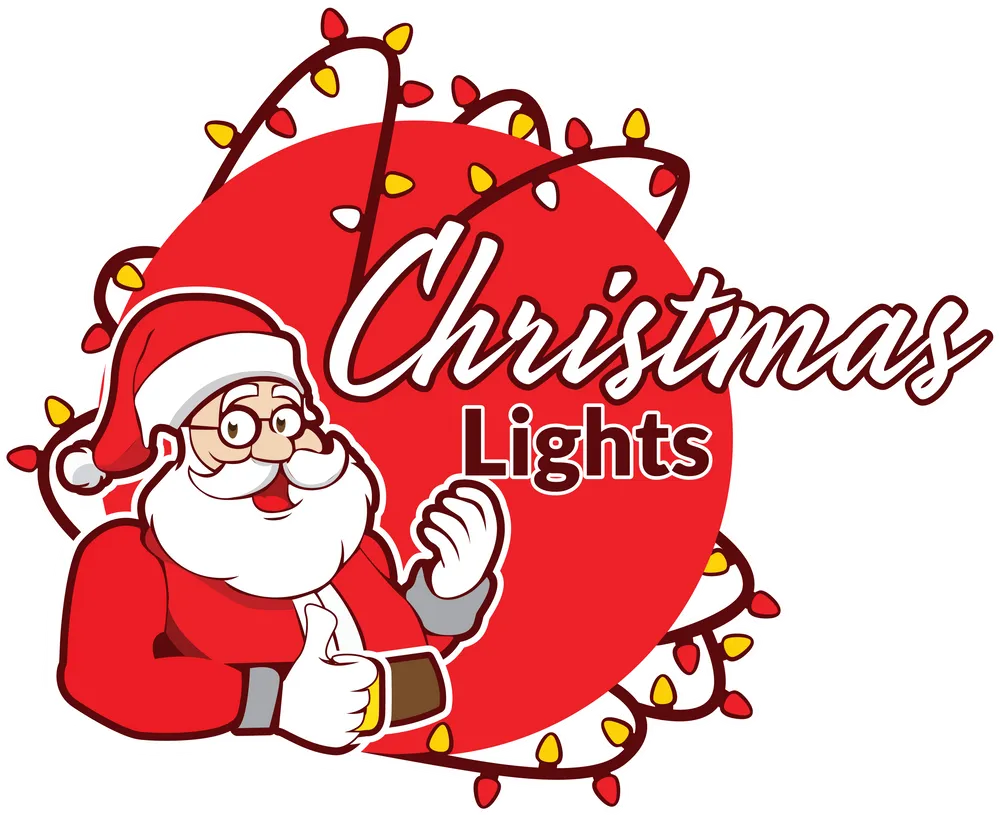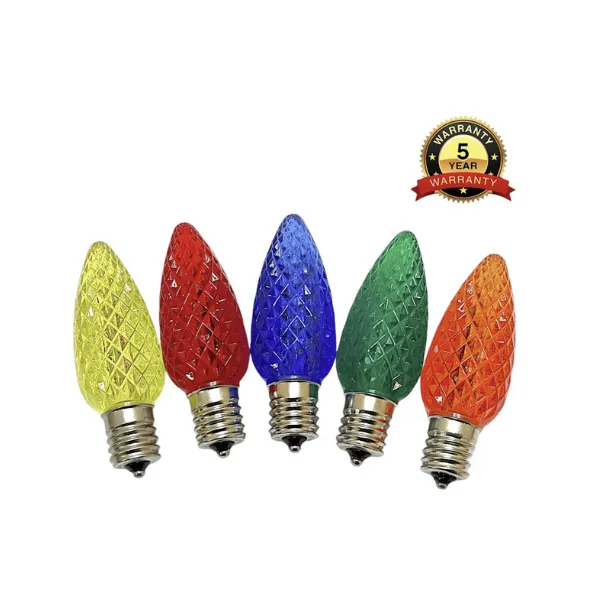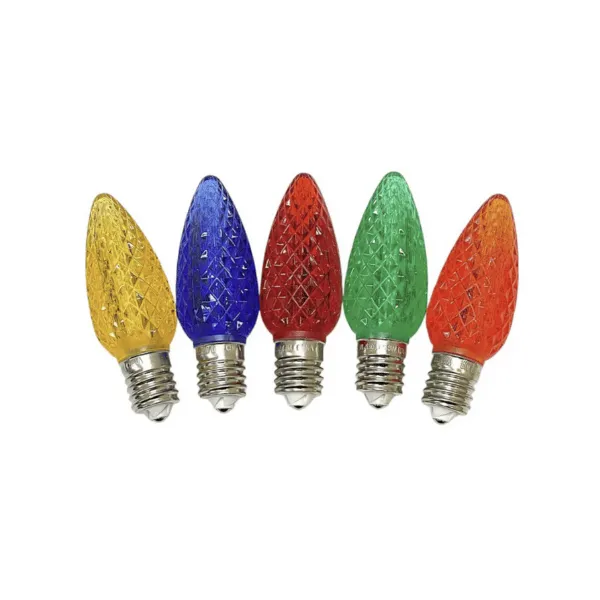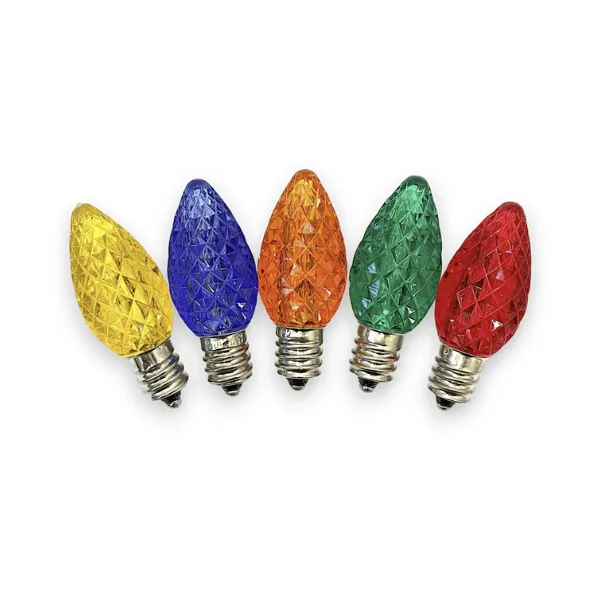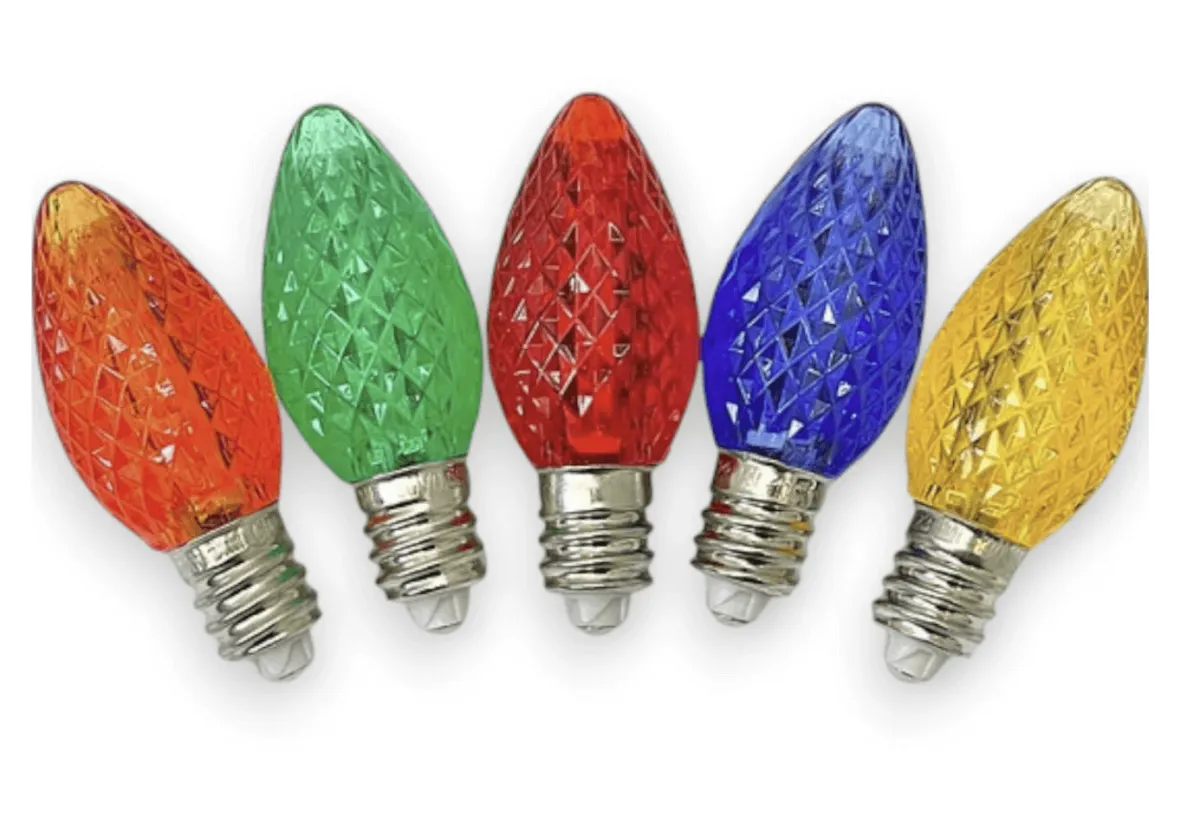Wholesale Pricing Presale Christmas Lights Bulbs
Pre-Season C9 Commercial Elite LED Bulbs
AS LOW AS $.50 Per BULB!
Want to know how to get the cheapest Christmas lights at wholesale pricing?
The more you buy, the more you save!
Experience the next level of holiday lighting with our C9 Commercial Elite SMD LED bulbs, featuring advanced Surface-Mounted Device (SMD) LED technology. These bulbs are designed to shine brighter and last longer, all while maintaining exceptional durability and energy efficiency. Perfect for both indoor and outdoor use, these bulbs are a must-have for any professional or residential Christmas light display.
5-Year Warranty – Best in the Industry
Our C9 Commercial Elite SMD LED bulbs are backed by an industry-leading 5-year warranty, ensuring that your investment in top-quality holiday lighting is fully protected. These bulbs are designed to shine brighter, last longer, and perform better, making them the ultimate choice for both professional and residential Christmas light displays.
Key Features:
SMD LED Technology: Offers a more brilliant light source with a reflective core design for superior optics, ensuring your
Virtually Unbreakable Construction: Highly durable bulbs are built to last, with a lifespan of up to 60,000 hours. These bulbs are designed to withstand the rigors of outdoor installations, making them virtually unbreakable.
Nickel-Plated Bases: Prevent corrosion and improve connectivity, saving you time and money during installation and ensuring reliable performance throughout the season.
Energy Efficient: Low wattage LED bulbs reduce power consumption by up to 90%, allowing you to safely create longer runs of light without overloading circuits.
Cool to the Touch: LED bulbs remain cool, even after hours of operation, making them safer to handle and install.
Larger Diamond-Cut Pattern: Faceted bulbs feature a diamond-cut design that generates beautiful light halos, adding a touch of elegance to any display.
Pre-Season C9 Minleon V2 LED Bulbs
AS LOW AS $.47 Per BULB!
Enhance your professional-grade Christmas lighting displays with Minleon V2 LED C9 bulbs. Featuring a faceted finish, these bulbs cast a bright and inviting light, making them an ideal choice for creating stunning, energy-efficient holiday displays.
Upgrade your holiday lighting with Minleon V2 C9 LED Christmas Light bulbs and experience the benefits of bright, energy-efficient, and durable lighting solutions.
Key Features:
Durable Multi-Faceted Construction: These Minleon V2 LED bulbs are crafted from high-quality, multi-faceted plastic, ensuring they resist fading, chipping, and breaking. This durability makes them perfect for both commercial and residential installations, maintaining their vibrant appearance season after season.
Energy Efficiency: These LED Christmas light bulbs reduce power consumption by more than 90% compared to traditional incandescent bulbs. With an actual power consumption of just 0.58W, they allow for longer runs and lower energy costs, though it’s recommended to use 2W for installation calculation purposes.
Standard C9 Socket Compatibility: Designed to fit any standard C9 socket with an E17 base, these LED bulbs integrate seamlessly into your existing lighting setups, making them versatile and easy to use for any holiday lighting project.
Upgrade your holiday displays with our C7 SMD LED bulbs, featuring advanced Surface-Mounted Device (SMD) LED technology. These bulbs are designed to shine brighter, last longer, and provide exceptional durability, making them an excellent choice for both residential and commercial Christmas lighting.
Key Features:
SMD LED Technology: Experience a more brilliant light source with SMD LED bulbs. The reflective core design enhances optics, ensuring your holiday displays are vibrant and eye-catching.
Virtually Unbreakable: These C7 LED bulbs are constructed from highly durable materials, making them virtually unbreakable. With a lifespan of up to 60,000 hours, they are built to withstand the rigors of outdoor and indoor installations.
Nickel-Plated Bases: The nickel-plated bases prevent corrosion and improve connectivity, saving you time and money during installation and ensuring long-lasting performance.
Larger Diamond-Cut Pattern: The bulbs feature a diamond-cut pattern with larger facets, generating beautiful light halos that add a touch of elegance to any holiday display.
Energy Efficiency: These low wattage LED bulbs reduce power consumption by up to 90% compared to traditional incandescent bulbs. This allows you to safely make longer runs of light without overloading circuits, making them ideal for large-scale installations.
Cool to the Touch: LED technology ensures that the bulbs remain cool, even after hours of use, enhancing safety during installation and operation.
Indoor/Outdoor Use: Perfect for both indoor and outdoor settings, these C7 SMD LED bulbs are versatile enough to meet all your holiday lighting needs.
Our super bright and brilliant Multi Minleon V2 LED C7 replacement bulbs will save you money on your electric bill this year and for many more Christmas holidays to come.
Key Features:
These bulbs are made of durable, multi-faceted plastic so they won't fade, chip, or break like incandescent bulbs
Reduce your power consumption by more than 90% compared with conventional incandescent bulbs)
0.58W and 0.66W actual power consumption, but use 2W for installation calculation purposes
Fits into any standard C7 socket; E12 base
Frequently Asked Questions
What’s the difference between C9 and C7 LED bulbs?
C9 bulbs are slightly larger than C7 bulbs, making them ideal for larger displays such as rooflines, trees, and commercial decorations. C7 bulbs are smaller and better suited for smaller spaces, window frames, or accent lighting.
Are C9 and C7 bulbs interchangeable?
While both C9 and C7 bulbs use standard bases (E17 for C9 and E12 for C7), they are not interchangeable due to their size differences. Be sure to match your sockets to the correct bulb size.
Are C9 and C7 LED bulbs energy-efficient?
Yes! C9 and C7 LED bulbs consume up to 90% less energy than traditional incandescent bulbs. This energy efficiency allows you to safely run longer strands without overloading circuits.
Can I use C9 and C7 LED bulbs outdoors?
Absolutely! Both C9 and C7 LED bulbs are designed for indoor and outdoor use. They are highly durable, weather-resistant, and can withstand extreme temperatures, making them perfect for any holiday display.
Do C9 and C7 LED bulbs come in different colors?
Yes, C9 and C7 LED bulbs are available in a wide variety of colors, including warm white, cool white, red, green, blue, yellow, and multi-color options, allowing you to customize your holiday lighting displays.
How long do C9 and C7 LED bulbs last?
C9 and C7 LED bulbs are built to last with a lifespan of up to 60,000 hours. Their durable construction ensures they remain bright and vibrant season after season.
Discover Expert Tips on Our Blog

Double Your Christmas Lights Profits: The 2 Numbers You Can’t Ignore!
In the competitive world of professional Christmas lights installation, many business owners focus extensively on the technical aspects—learning about bulb types, installation techniques, and design principles. While these skills are undoubtedly important, they're not what separates successful businesses from those that struggle. The real difference lies in understanding the business side of your Christmas lights operation.
As someone who has coached countless Christmas lights and pressure washing entrepreneurs to seven-figure businesses, I've identified two critical numbers that will dramatically impact your growth potential. These aren't complicated metrics requiring advanced accounting knowledge—they're straightforward numbers that anyone can track and improve.
The Two Numbers That Will Transform Your Business
The two most important numbers you need to monitor consistently are:
1. Average Ticket Value
2. Close Rate
Let's dive deep into why these metrics matter so much and how improving them can completely transform your Christmas lights installation business.
Average Ticket Value: The Key to Working Less While Earning More
Your average ticket is simply the total revenue divided by the number of jobs completed. For instance, if you completed 20 jobs this month and generated $40,000 in revenue, your average ticket is $2,000.
Many Christmas lights installers casually estimate their average ticket: "It's between $800 and $1,200." But this vague approximation indicates you don't truly know your numbers. When you calculate it precisely, you'll likely find it's either significantly higher or lower than you thought.
What Should Your Christmas Lights Average Ticket Be?
For Christmas lights installation, your average ticket should be at least $1,500+. If your average is below this threshold, you're leaving significant money on the table and working harder than necessary.
I've coached installers who built businesses with average tickets exceeding $2,800 on residential projects alone. This didn't come from occasional commercial whale projects—it came from strategic pricing and packaging of residential services.
Why Higher Average Tickets Matter
When you increase your average ticket, you can:
1. Work less while maintaining or increasing revenue. Completing 30 jobs at $2,000 each generates more revenue than 60 jobs at $900 each—with half the travel time, setup/teardown, and administrative work.
2. Reduce overhead costs. Fewer jobs mean lower fuel costs, less equipment wear and tear, and reduced chemical/material expenses.
3. Lower your risk profile. Every Christmas lights installation carries inherent risks—from ladder accidents to property damage. By doing fewer, higher-value jobs, you reduce your overall exposure to these risks.
4. Create more time for high-value activities. With fewer jobs on your schedule, you gain time for business development, marketing, and strategic planning.
5. Deal with fewer problem customers. The 80/20 rule applies perfectly here—20% of customers typically create 80% of headaches. Fewer total customers mean fewer problem customers.

How to Increase Your Average Ticket
Here are proven strategies to boost your average ticket value:
1. Bundle Services Strategically
Instead of offering simple roofline lighting, create comprehensive packages that include:
- Front of house lighting (8-10 dollars per foot)
- Custom wreaths ($400-500)
- Ground lighting around walkways and landscape features
- Tree wrapping
- Yard decorations
When you present these as cohesive packages rather than à la carte options, customers perceive greater value and are more likely to spend more.
2. Implement Tier Pricing
Create three distinct service tiers:
- Good: Basic lighting package (roofline, simple features)
- Better: Enhanced package with added features (roofline, premium bulbs, wreath, some ground lighting)
- Best: Premium comprehensive package (full home coverage, custom features, premium products)
This pricing psychology works because most customers will select the middle option—which should be priced significantly higher than your current average ticket.
3. Focus on Value, Not Price
When customers understand the value they're receiving—professional installation, premium products, hassle-free service, expert design—they're willing to pay more. Communicate this value clearly during sales conversations.
One installer I coached increased his average ticket by 35% simply by restructuring his packages and focusing his sales pitch on the premium experience rather than the basic service.
Close Rate: Finding Your Sweet Spot
Your close rate is the percentage of quotes that convert to paying jobs. It's calculated by dividing the number of jobs won by the total number of quotes provided.
Many Christmas lights installers are proud of their high close rates—90% or higher—but this is actually a warning sign. A close rate that high typically means your prices are too low.
The Ideal Close Rate for Christmas Lights Installation
For Christmas lights installation, your optimal close rate should be between 10% and 20%. This might seem counterintuitive, but it's based on a fundamental business principle: you don't want or need every potential customer.
A 10-20% close rate indicates that:
1. Your prices reflect the premium value you provide
2. You're targeting the right customer segment (those who value quality over bargain pricing)
3. You're not competing solely on price with lower-quality providers
The Relationship Between Close Rate and Pricing
There's an inverse relationship between your close rate and your prices. As you raise prices, your close rate will naturally decrease—but your profitability will increase if you find the right balance.
Consider this example:
- Scenario A: 90% close rate with a $500 average ticket = $45,000 revenue from 100 quotes
- Scenario B: 15% close rate with a $2,000 average ticket = $30,000 revenue from 100 quotes
At first glance, Scenario A appears better—more revenue from the same number of quotes. But when you factor in the reduced workload (15 jobs vs. 90 jobs), lower operational costs, and decreased risk exposure, Scenario B offers far greater profitability and sustainability.
Why You Shouldn't Chase Every Customer
The 80/20 principle applies powerfully here: 20% of customers typically provide 80% of your revenue—and they're usually your highest-paying, least problematic clients.
By pricing strategically to target this top 20%, you:
1. Work with clients who truly value your expertise
2. Reduce headaches from price-sensitive customers
3. Create a sustainable business model that doesn't burn you out
4. Build a reputation as a premium service provider

How to Optimize Your Close Rate
To reach that 10-20% sweet spot:
1. Gradual Price Increases
If your close rate exceeds 50%, systematically increase your prices until you reach the optimal range. This doesn't mean arbitrary price hikes—it means aligning your pricing with the premium value you provide.
2. Improve Your Sales Approach
When quoting higher prices, your sales approach becomes more important. Focus on:
- Understanding client needs through thoughtful questioning
- Educating prospects about the value differences between quality installation and budget options
- Creating visual proposals that showcase your premium design approach
- Emphasizing safety, reliability, and hassle-free service
3. Target Higher-Value Neighborhoods
Your marketing efforts should focus on neighborhoods and areas where homeowners have both the means and desire for premium holiday lighting. This strategic targeting naturally aligns your close rate with the right customer base.
Tracking and Improving These Metrics
Knowing these numbers is just the starting point—you need to actively track and work to improve them.
Regular Monitoring
Review your average ticket and close rate:
- Weekly during peak season
- Monthly year-round
- Quarterly for trend analysis
- Annually for strategic planning
Most CRM systems can generate these reports automatically. If yours doesn't, create a simple spreadsheet to track:
- Quote date
- Quote amount
- Whether it converted to a sale
- Final invoice amount
Setting Improvement Targets
Once you know your current metrics, set specific improvement goals:
- "Increase average ticket from $800 to $1,000 this season"
- "Adjust close rate from 70% to 40% while increasing average ticket by 50%"
These concrete targets give you something to work toward and measure your progress against.
Seasonal Analysis
Compare your metrics across different seasons and years. This historical data helps you:
- Identify which months have the highest potential for premium sales
- Recognize when you need to adjust pricing or marketing strategies
- Plan your resources more effectively for busier periods

The 80/20 Rule in Christmas Lights Installation
The Pareto Principle (80/20 rule) applies powerfully to Christmas lights installation:
- 20% of your customers generate 80% of your revenue
- 20% of your customers create 80% of your problems
- 20% of your marketing efforts produce 80% of your leads
By understanding this principle, you can focus your energy on the clients, services, and marketing channels that deliver the greatest return.
Following Up: The Difference Between Success and Failure
One final critical point: follow-up is essential to converting premium customers. The saying "If you don't follow up, you'll fold up" is absolutely true in this business.
Implement a systematic follow-up process:
- Send text messages to check decision status
- Make phone calls to answer any questions
- Provide additional information that addresses specific concerns
- Follow up with past customers to secure repeat business
One installer generated $18,000 in additional revenue simply by sending 50 text messages to past customers—a five-minute task that yielded significant returns.
Building a Sustainable Christmas Lights Business
The path to a profitable, sustainable Christmas lights installation business isn't through working harder—it's through working smarter by understanding and optimizing these two critical numbers.
When you increase your average ticket value while maintaining a strategic close rate, you create a business model that:
1. Maximizes your profit per hour worked
2. Reduces physical strain and burnout risk
3. Positions you as a premium service provider
4. Creates a sustainable growth trajectory
Christmas lights installation can be a highly profitable seasonal business that complements pressure washing or other home services. By focusing on these two numbers—average ticket and close rate—you'll build a business that not only survives but thrives for years to come.
Remember: Don't compete on price; compete on value. The customers worth having will recognize and pay for the difference.

What are the two most important numbers I should track in my Christmas lights business?
Answer: The two most critical numbers every Christmas lights installer should track are your average ticket value and your close rate. Your average ticket is the total revenue divided by the number of jobs completed, while your close rate is the percentage of quotes that convert to paying jobs. Together, these metrics provide powerful insights into your business's health and growth potential.
What should my average ticket be for Christmas lights installation?
Answer: For a profitable Christmas lights installation business, your average ticket should be at least $1,500 or higher. Many successful installers maintain average tickets of $2,000-$2,800 for residential projects. If your average ticket is below $1,500, you're likely leaving significant money on the table and working harder than necessary to achieve your revenue goals.
My close rate is 90% - isn't that a good thing?
Answer: While a high close rate might seem positive, a close rate of 90% typically indicates your prices are too low. For Christmas lights installation, the optimal close rate should be between 10-20%. This lower rate shows you're targeting the right customer segment (those who value quality over bargain pricing) and charging appropriately for the premium service you provide. Remember: you don't want or need every potential customer.
How can I increase my average ticket value?
Answer: You can increase your average ticket by:
- Bundling services (combining roofline lighting with wreaths, ground lighting, tree wrapping, etc.)
- Implementing tier pricing (good, better, best options)
- Charging appropriately for premium services (8-10 dollars per foot for lights)
- Adding high-value elements like custom wreaths ($400-500)
- Focusing your sales pitch on value rather than price
- Offering comprehensive packages rather than à la carte options
Won't raising my prices drive away customers?
Answer: Yes, raising prices will reduce your close rate—and that's actually the goal. By finding the right balance between price and close rate, you'll work with fewer, higher-quality customers who value your expertise. This allows you to do less work for the same or better revenue while reducing overhead costs, minimizing risk exposure, and creating more time for high-value business activities.
How often should I review my business metrics?
Answer: You should review your average ticket and close rate:
- Weekly during peak season
- Monthly year-round
- Quarterly for trend analysis
- Annually for strategic planning
Regular monitoring helps you identify trends, set improvement targets, and make data-driven decisions about pricing and marketing strategies.

Is it worth doing small jobs for less than $1,000?
Answer: Generally, small jobs under $1,000 are not worth pursuing for professional Christmas lights installers. Each job carries setup costs, travel time, administrative work, and risk exposure regardless of size. By focusing on higher-value projects, you can maintain or increase revenue while significantly reducing your workload and operational costs. The goal is to maximize your profit per hour worked.
How does the 80/20 rule apply to my Christmas lights business?
Answer: The 80/20 rule (Pareto Principle) applies powerfully to Christmas lights installation:
- 20% of your customers generate 80% of your revenue
- 20% of your customers create 80% of your problems
- 20% of your marketing efforts produce 80% of your leads
By understanding this principle, you can focus your energy on the clients, services, and marketing channels that deliver the greatest return.
How important is follow-up in the sales process?
Answer: Follow-up is absolutely critical to converting premium customers. Without systematic follow-up, you're leaving significant money on the table. Implement a process that includes text messages, phone calls, and emails to check decision status and address specific concerns. Follow up with past customers to secure repeat business as well. One installer generated $18,000 in additional revenue simply by sending 50 text messages to past customers.
Can I really charge $8-10 per foot for Christmas lights in my area?
Answer: Yes, you absolutely can charge $8-10 per foot in virtually any market if you position yourself as a premium service provider. While some installers claim their market won't support these rates, others in the same geographical areas successfully charge premium prices. The difference lies in marketing strategy, target customer base, and the ability to communicate value rather than competing on price. Customers who value quality, convenience, and expertise will pay premium rates for exceptional service.
Copyright ©2024 All Right Reserved website designed by christmaslights.io
Terms of Service / Privacy Policy
Have questions or need assistance?
Contact us at (855)619-LITE

